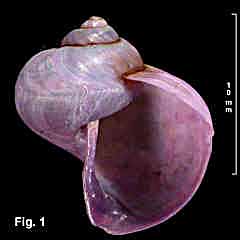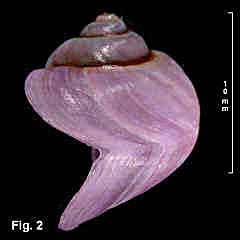|
|
|
|
|
Janthina umbilicata D'Orbigny, 1840 Description: Shell lightweight, globose, aperture more than half shell length. Spire whorls and last whorl rounded. Whorls sculptured with strong V-shaped ridges following curves of outer lip, spiral groove or ridge at periphery of last whorl; a few weak spirals grooves on base. Outer lip (when unbroken) with deep simus at periphery. Umbilicus closed or partly open. Colour purple, with diffuse pale violet band below suture. Size: Up to 14 mm in length. Distribution: Worldwide in tropical and temperate seas; available Australian specimens range from northern Queensland southwards to eastern Victoria. Habitat: Pelagic; found washed up on ocean beaches; uncommon in NSW. Comparison: Shells of J. exigua and J. umbilicata are almost identical apart from the strength of the sculpture. In J. exigua the V-shaped growth ridges are very strong and widely spaced, but in J. umbilicata they are fine and closely spaced. There seems to be no sculptural integrades, although in J. exigua the sculpture does vary in strength, but is never as fine as that of J. umbilicata. Laursen (1953) gave additional differences for the two species, based on radula and egg characters. Synonymy: An incorrect identification Janthina nitida A. Adams, 1869 was used by Iredale & McMichael (1962) for this species. Remarks: This is a pelagic species as described in the introduction to this family. It floats on the surface of the sea utilizing a float secreted by the foot. Egg capsules are attached to the float. Figs.1, 2: Manly Beach, NSW (C.056810) |

